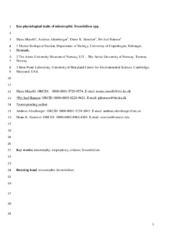Ecophysiological traits of mixotrophic Strombidium spp
Permanent link
https://hdl.handle.net/10037/19430Date
2020-09-07Type
Journal articleTidsskriftartikkel
Peer reviewed
Abstract
Ciliates represent an important trophic link between nanoplankton and mesoplankton. Many species acquire functional chloroplasts from photosynthetic prey, being thus mixotrophs. Little is known about which algae they exploit, and of the relevance of inorganic carbon assimilation to their metabolism. To get insights into these aspects, laboratory cultures of three mixotrophic Strombidium spp. were established and 35 photosynthetic algal species were tested as prey. The relative contributions of ingestion and photosynthesis to total carbon uptake were determined, and responses to prey starvation were studied. Ciliate growth was supported by algal species in the 2–12 μm size range, with cryptophytes and chlorophytes being the best prey types. Inorganic carbon incorporation was only quantitatively important when prey concentration was low (3–100 μgCL−1), when it led to increased gross growth efficiencies. Chla specific inorganic carbon uptake rates were reduced by 60–90% compared to that of the photosynthetic prey. Inorganic carbon uptake alone could not sustain survival of cultures and ciliate populations declined by 25–30% during 5 days of starvation. The results suggest that mixotrophy in Strombidium spp. may substantially bolster the efficiency of trophic transfer when biomass of small primary producers is low.
Description
This is a pre-copyedited, author-produced version of an article accepted for publication in Journal of Plankton Research following peer review. The version of record Maselli, M., Altenburger, A., Stoecker, D. K. & Hansen, P. J. (2020). Ecophysiological traits of mixotrophic Strombidium spp. Journal of Plankton Research, 42(5), 485-496 is available online at: https://doi.org/10.1093/plankt/fbaa041.
Publisher
Oxford University Press (OUP)Citation
Maselli, Altenburger A, Stoecker DK, Hansen PJ. Ecophysiological traits of mixotrophic Strombidium spp. Journal of Plankton Research. 2020;42(5):485-496Metadata
Show full item recordCollections
Copyright 2020 The Author(s)


 English
English norsk
norsk